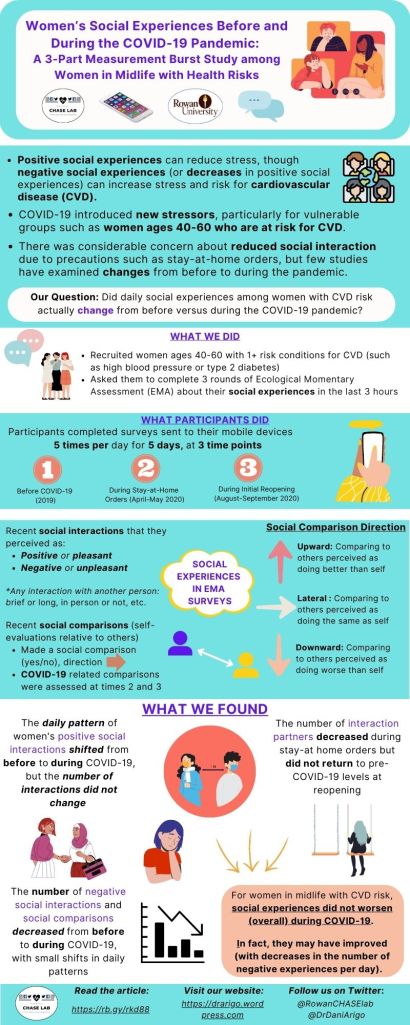Sofia Gular has a B.A. in Psychology from Rowan University and joined the CHASE Research Team as our lab manager in May 2023. She was interviewed by Iris Bercovitz, a second-year student Clinical Psychology Ph.D. student at Rowan.
Rowan CHASE Lab: Hi Sofia! It’s great to talk with you. What first made you interested in joining the CHASE lab in the role of lab manager?
SG: Hi Iris! It’s great to talk with you, too. The CHASE lab piqued my interest as I found the work to be not only interesting but hugely important. Digital health tools are becoming more prominent in our daily lives, and being able to use these tools to promote physical activity was an effort I wanted to contribute to. More specifically, the role of lab manager provides me the opportunity to further develop my skill set, not only as a researcher but as a professional. I was previously a research assistant during my undergraduate career, so this opportunity was a way to further build upon those skills and experiences.
Rowan CHASE Lab: I know that you recently earned an undergraduate degree in Psychology from Rowan. What research experience did you have before joining CHASE lab, and how did they inform your interest in working with us?
SG: During my undergraduate career, I first ventured into the world of research during a summer research internship I did under the supervision of NIDA at University of Penn’s AHA! Lab, which focused on smoking cessation. This was my first real introduction to research methods and practices, and I took part in my first individual research project using intensive assessment data (study used an ecological momentary assessment design). From there, I went on to work with the ASSeRT lab at Rowan, where I was able to gain even more experience in data collection, survey building, and presenting at conferences. I found it really interesting that the CHASE lab often uses ecological momentary assessment (or EMA), which contributed to my interest in working with this lab specifically. Ultimately, my desire to become more involved in psychological research coupled with my experience in learning about EMA nurtured my interest in working for the CHASE lab.
Rowan CHASE Lab: In addition to being lab manager, what research experiences are you interested in gaining with the CHASE lab? Do you have a particular area of research interest?
SG: I hope to gain experience in leading my own projects and to present research at new conferences. In addition, I would love to assist and support the many projects the lab is currently working on, to better understand the many facets of research and develop my ability to both lead and work with a team. Specifically, I would like to gain more experience in data management and analysis, as these skills are vital to performing research. I am particularly interested in physical activity as it relates to pain and sleep. In the future, I would love to take on my own projects that examine what factors influence outcomes like sleep quality and daily experiences with pain.
Rowan CHASE Lab: From your experience so far, what have been the most interesting aspects of being a lab manager?
SG: Most interesting so far has been reflecting on what helped me become a better research assistant and paying that forward to undergraduate students working with the CHASE Lab. Understanding what has helped me in my journey and sharing that information has been really interesting for my own personal reflection, but also in learning how to be a good supporter of our team. It has also been really interesting to learn about the many facets of health psychology and I have enjoyed learning more about health behaviors as they relate to psychology – this is an area of psychology where I did not have much exposure prior to joining the lab.
Rowan CHASE Lab: What do you anticipate to be the most challenging parts of being lab manager?
SG: Learning how to juggle multiple active projects and tasks at a time. As a student, we learn how to juggle working, school work, internships, etc. Now as a lab manager, I have to use those skills I honed during my undergraduate career to not only manage my schedule, but to assist in managing the lab’s schedule and staying on top of tasks and deadlines. I am eager to learn how to best stay organized in this context and to build on these skills.
Rowan CHASE Lab: We also love to get to know our team as more than just their research interests and experience. What kinds of things do you enjoy doing in your free time?
SG: I have two cats at home who I love to spend time with every day. Also, I really enjoy exploring new places, especially parks and nature reserves. Aside from that, I love spending quality time with my family and friends. Those interactions help me stay grounded, especially in times of stress. Lastly, I prioritize staying active (like going for runs, weight training) – not only to stay physically healthy but to stay mentally healthy as well!
Rowan CHASE Lab: Last question. What are your future career goals?
SG: I aspire to one day work as a clinical psychologist in an inpatient setting. I would also love the opportunity to teach at a university in some capacity. My next step is to continue getting relevant experience in the field to make myself a strong candidate for clinical psychology graduate programs!

